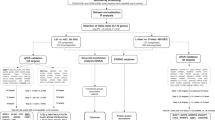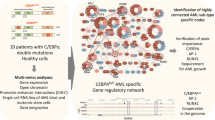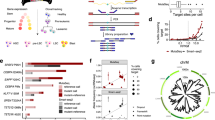Abstract
Chronic myeloid leukemia (CML) is characterized by the clonal expansion of hematopoietic stem cells (HSCs). Without effective treatment, individuals in the indolent, chronic phase (CP) of CML undergo blast crisis (BC), the prognosis for which is poor. It is therefore important to clarify the mechanism underlying stage progression in CML. DNA microarray is a versatile tool for such a purpose. However, simple comparison of bone marrow mononuclear cells from individuals at different disease stages is likely to result in the identification of pseudo-positive genes whose change in expression only reflects the different proportions of leukemic blasts in bone marrow. We have therefore compared with DNA microarray the expression profiles of 3456 genes in the purified HSC-like fractions that had been isolated from 13 CML patients and healthy volunteers. Interestingly, expression of the gene for PIASy, a potential inhibitor of STAT (signal transducer and activator of transcription) proteins, was down-regulated in association with stage progression in CML. Furthermore, forced expression of PIASy has induced apoptosis in a CML cell line. These data suggest that microarray analysis with background-matched samples is an efficient approach to identify molecular events underlying the stage progression in CML.
This is a preview of subscription content, access via your institution
Access options
Subscribe to this journal
Receive 50 print issues and online access
$259.00 per year
only $5.18 per issue
Buy this article
- Purchase on Springer Link
- Instant access to full article PDF
Prices may be subject to local taxes which are calculated during checkout






Similar content being viewed by others
References
Alon U, Barkai N, Notterman DA, Gish K, Ybarra S, Mack D, Levine AJ . 1999 Proc. Natl. Acad. Sci. USA 96: 6745–6750
Boel P, Wildmann C, Sensi ML, Brasseur R, Renauld JC, Coulie P, Boon T, van der Bruggen P . 1995 Immunity 2: 167–175
Carlesso N, Frank DA, Griffin JD . 1996 J. Exp. Med. 183: 811–820
Chu G, Chang E . 1988 Science 242: 564–567
Duggan DJ, Bittner M, Chen Y, Meltzer P, Trent JM . 1999 Nat. Genet. 21: 10–14
Era T, Witte ON . 2000 Proc. Natl. Acad. Sci. USA 97: 1737–1742
Gouilleux-Gruart V, Debierre-Grockiego F, Gouilleux F, Capiod JC, Claisse JF, Delobel J, Prin L . 1997 Leuk. Lymphoma 28: 83–88
Hin AH, Miraglia S, Zanjani ED, Almeida-Porada G, Ogawa M, Leary AG, Olweus J, Kearney J, Buck DW . 1997 Blood 90: 5002–5012
Iida A, Chen S-T, Friedmann T, Yee J-K . 1996 J. Virol. 70: 60545–60549
Izumi M, Miyazawa H, Kamakura T, Yamaguchi I, Endo T, Hanaoka F . 1991 Exp. Cell Res. 197: 229–233
Jang SK, Davies MV, Kaufman RJ, Wimmer E . 1989 J. Virol. 63: 1651–1660
Kantarjian HM, Deisseroth A, Kurzrock R, Estrov Z, Talpaz M . 1993 Blood 82: 691–703
Kawai T, Matsumoto M, Takeda K, Sanjo H, Akira S . 1998 Mol. Cell. Biol. 18: 1642–1651
Lethe B, Lucas S, Michaux L, De Smet C, Godelaine D, Serrano A, De Plaen E, Boon T . 1998 Int. J. Cancer 76: 903–908
Liu B, Gross M, ten Hoeve J, Shuai K . 2001 Proc. Natl. Acad. Sci. USA 98: 3203–3207
Loeffen JLCM, Triepels RH, van den Heuvel LP, Schuelke M, Buskens CAF, Smeets RJP, Trijbels JMF, Smeitink JAM . 1998 Biochem. Biophys. Res. Commun. 253: 415–422
Miyazato A, Ueno S, Ohmine K, Ueda M, Yoshida K, Yamashita Y, Kaneko T, Mori M, Kirito K, Toshima M, Nakamura Y, Saito K, Kano Y, Furusawa S, Ozawa K, Mano H . 2001 Blood 98: 422–427
Onishi M, Kinoshita S, Morikawa Y, Shibuya A, Phillips J, Lanier LL, Gorman DM, Nolan GP, Miyajima A, Kitamura T . 1996 Exp. Hematol. 24: 324–329
Shuai K . 2000 Oncogene 19: 2638–2644
Silver RT, Woolf SH, Hehlmann R, Appelbaum FR, Anderson J, Bennett C, Goldman JM, Guilhot F, Kantarjian HM, Lichtin AE, Talpaz M, Tura S . 1999 Blood 94: 1517–1536
Van Gelder RN, von Zastrow ME, Yool A, Dement WC, Barchas JD, Eberwine JH . 1990 Proc. Natl. Acad. Sci. USA 87: 1663–1667
MG, Szpirer J, Nols CB, Clauss IM, De Wit L, Islam MQ, Levan G, Horisberger MA, Content J, Szpirer C, et al . 1988 Somat. Cell. Mol. Genet. 14: 415–426
Yamashita Y, Kajigaya S, Yoshida K, Ueno S, Ota J, Ohmine K, Ueda M, Miyazato A, Ohya K, Kitamura T, Ozawa K, Mano H . 2001 J. Biol. Chem. 276: 39012–39020
Acknowledgements
We are grateful to A Iida and J-K Yee for the kind gifts of tTAER cDNA and the tetO fragment, and T. Kitamura for the pMX vector. This work was supported in part by a Grant-in-Aid for Research on the Second-Term Comprehensive 10-Year Strategy for Cancer Societies from the Ministry of Health and Welfare of Japan, by a Grant-in-Aid for Scientific Research on Priority Areas from the Ministry of Education, Science, Sports, and Culture of Japan, and by the Science Research Promotion Fund of the Promotion and Mutual Aid Corporation for Private Schools of Japan. J Ota is a research resident of the Japan Health Sciences Foundation.
Author information
Authors and Affiliations
Corresponding author
Rights and permissions
About this article
Cite this article
Ohmine, K., Ota, J., Ueda, M. et al. Characterization of stage progression in chronic myeloid leukemia by DNA microarray with purified hematopoietic stem cells. Oncogene 20, 8249–8257 (2001). https://doi.org/10.1038/sj.onc.1205029
Received:
Revised:
Accepted:
Published:
Issue Date:
DOI: https://doi.org/10.1038/sj.onc.1205029
Keywords
This article is cited by
-
PIAS4 is an activator of hypoxia signalling via VHL suppression during growth of pancreatic cancer cells
British Journal of Cancer (2013)
-
Tyrosine kinase chromosomal translocations mediate distinct and overlapping gene regulation events
BMC Cancer (2011)
-
Molecular signature of CD34+ hematopoietic stem and progenitor cells of patients with CML in chronic phase
Leukemia (2007)
-
Chronic myeloid leukaemia as a model of disease evolution in human cancer
Nature Reviews Cancer (2007)
-
Genome-wide approach to identify risk factors for therapy-related myeloid leukemia
Leukemia (2006)



